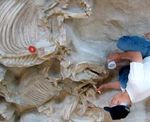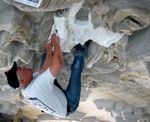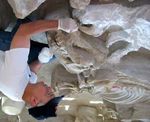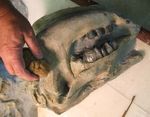Molding and Casting of In-situ Articulated Skeletons in Soft Matrix: A Case Study from the Ashfall Fossil Beds, Nebraska
←
→
Page content transcription
If your browser does not render page correctly, please read the page content below
Molding and Casting of In-situ Articulated Skeletons in Soft Matrix:
A Case Study from the Ashfall Fossil Beds, Nebraska
Gregory Brown, University of Nebraska State Museum, W-436 Nebraska Hall UNL, Lincoln, NE 68588-0514
GBROWN1@UNL.EDU
ABSTRACT covered, partially enclosed structure built over a portion of
the site. Since the skeletons are still in contact with the ash
Due in part to their excellent release properties and variable substrate, however, they are exposed to considerably more
viscosities, modern silicone molding materials have greatly environmental influences than a typical museum collection.
simplified the process of molding and casting well-preserved In-situ “storage” is essentially an “open system”, thus long-
fossil specimens in the laboratory. Porous bone and, in term preservation is always a major challenge.
particular, bone still partially embedded in a soft and porous
matrix, however, still present serious challenges to Ever since its discovery in 1972 (UNSM Locality Ap-116,
successful molding. In addition, uncontrolled environmental Poison Ivy Quarry), it has been our dream to mold and cast a
conditions, lack of access to standard laboratory equipment, representative sample of the articulated skeletons from
and unique conservation concerns multiply these challenges Ashfall. In addition to their obvious scientific importance,
significantly when molding specimens remaining is-situ. these unique fossils, preserved in their death-poses and
maintained in-situ, provide an ideal setting for informal
In 2004, we began a project to mold several complete, science education. Exhibits developed from casts of these
articulated Clarendonian rhino (Teleoceras) and horse specimens would extend the reach of this education resource
(Cormohipparion) skeletons preserved in-situ in soft well beyond the park boundaries. In addition, high-
volcanic ash at the Ashfall Fossil Beds near Orchard/Royal, resolution casts would also provide a permanent scientific
Nebraska. Although the overall design of the one-piece record of these unique specimens in the even of any
molds is relatively straightforward, achieving a flawless catastrophic loss at the site.
mold and assuring safe, stress-free demolding in this
situation requires subtle but important variations to our In 2004, a grant from the David Jones Foundation made this
standard molding procedures including: 1) the use of dream a reality. Funding was provided to allow us to mold
cyclododecane to seal porous matrix and bone, 2) control of and cast three specimens. From the dozens of skeletons
molding compound viscosities using fumed silica rather than preserved in the Rhino Barn, we selected:
liquid thixotropic additives, 3) incorporation of fabric
reinforcement into mold perimeter, and 4) choice of
addition-cure, platinum-catalyzed silicone RTV molding
compound for its superior release properties, long mold life,
and chemical resistance.
During casting, the use of talc-extended polyester resin
provides an ideal consistency for brush application and
results in a high-resolution bubble-free cast that readily
accepts acrylic paints and stains.
Maintaining substrate and specimen integrity while
minimizing alterative chemical treatments is an important
goal in all molding projects, but is essential to the long-term
survival of specimens being maintained in-situ under
minimal environmental control.
INTRODUCTION
Ashfall Fossil Beds State Historical Park, located in
northeast Nebraska, features a large deposit of Miocene Figure 1. Overview of a portion of the “Rhino Barn”,
volcanic ash containing the articulated skeletons of hundreds Ashfall Fossil Beds State Historical Park, Royal, Nebraska
of rhinos, horses, camels and associated Clarendonian fauna.
Specimens left in-situ are protected by the “Rhino Barn”, a1) An adult horse, Cormohipparion occidentale (nicknamed
“Cormo”).
2) An adult rhino Teleoceras major (nicknamed “Sandy”).
3) A calf rhino, probably Sandy’s offspring (nicknamed
“Justin”). To date, two of these molding/casting projects
have been completed. The large adult rhino “Sandy”,
scheduled for molding in 2009, will require a different
molding technique, discussed briefly at the end of this
paper.
CHALLENGES
Although the overall mold design required for these
specimens was relatively simple, there were several unusual
challenges that had to be addressed:
• The skeletons are preserved in a soft, un-cemented, porous
volcanic ash. Cohesiveness of the unconsolidated ash is
due solely to imbrication of individual glass shards.
• Effective penetration of consolidants into the ash is
limited to between one and two centimeters. This leaves
consolidated pedestals and the ash surrounding the
specimens superficially hard but structurally weak sub-
surface and thus prone to delamination or plucking during
de-molding.
• Maintaining the skeletons in-situ (in full contact with the
substrate) under minimal environmental controls makes
long-term preservation extremely tenuous. The use of Figure 2. Consolidating ash matrix with Acryloid
irremovable chemical separators or barrier coats to (Paraloid) B-72 prior to molding. Cormohipparion
facilitate mold release could interfere with ongoing occidentale.
conservation efforts and adversely impact long-term
preservation of the specimens.
• Lack of normal laboratory equipment and environmental
control complicates the molding process. Lack of a MOLDING
vacuum chamber to de-air molding compound, lack of
work-space temperature control, dust contamination, Selection of molding compound
specimen inaccessibility, distraction from park visitors, There are many molding compounds available. This project
etc. add potential difficulties to successful in-situ molding. required a compound with easily-controlled rheology,
minimal adhesion and good chemical resistance to casting
PREPARATION AND CONSOLIDATION resins. Polyurethane molding elastomers, commonly used in
model-making and industry, form a strong chemical adhesion
Actual excavation took place long before the molding project to most surfaces, requiring liberal use of a mold release
began, and utilized standard methods. Since the skeletons compound on the specimen. These compounds were deemed
were to be left in-situ indefinitely for viewing, however, they unsuitable for this project. Indeed, good conservation
were prepared far more completely than would normally be practice would suggest that they are seldom suitable for use
done in the field. Due to the soft nature of the ash substrate, on any scientific specimen. Silicone based molding
generous support pedestals were left around all specimens. compounds, however, do not chemically bond to most other
Consolidation of the specimens and ash matrix with Vinac B- materials; adhesion is strictly by microscopic mechanical
15 (polyvinyl acetate) proceeded as needed only after the interlocking (discussed later). There are two principle
specimens and surrounding matrix were dry. families of silicone molding compounds available, each with
a wide range of viscosities, cured-hardness and tear strength.
Approximately two weeks prior to molding, specimens were Both produce extremely high resolution molds:
again thoroughly consolidated, this time with Acryloid B-72 1) Condensation-cure tin-catalyzed silicone RTV is most
(ethyl methacrylate copolymer), concentrating on the ash commonly used in vertebrate paleontology molding
supporting the specimens and the sides of pedestals which laboratories. The principle advantage of these compounds is
would be subjected to molding (see Fig. 2) that they are generally lower in cost and less prone to cureinhibition. Tin-catalyzed systems suffer from some detail to disappear by sublimation. CDD remained in the
shrinkage (typically 0.3%) due to loss of generated alcohol matrix pore spaces, however, eliminating the problem of
after cure. 2) Addition-cure platinum-catalyzed silicone mold adhesion due to microscopic mechanical interlocking.
RTV is also available at a slightly higher cost. These
molding compounds are cure-inhibited by certain oils, Application of molding compound
amines, polyesters, sulfur and tin compounds, so more care PlatSil 73-29 has a low viscosity of about 15,000 cP and
and testing is required during their use. Platinum-catalyzed continues to flow for approximately one hour after
silicone RTV does not shrink during or after cure and, most application. While this is ideal for poured molds and detail
importantly for our project, has slightly better release capture, it is difficult to build up a suitable thickness in glove
properties. The cured product is also somewhat more molds, especially over high-relief areas, without “thickening
resistant to chemical attack by casting resins, which results up” the compound. Chemical thixotropic additives are
in longer mold life and more casts from each mold. available, but it is difficult to control the degree of flow of
the mold rubber with these; it often becomes a non-flowing,
We chose Polytek PlatSil 73-29 platinum-catalyzed RTV for stringy paste. We chose to thicken the initial coats, at least,
its superior tear strength, medium hardness (Shore A 30) and with about ¼ cup of Cab-O-Sil fumed silica per 150 gram
good flexibility, which make it ideally suited for brush-on batch of mold rubber. This formulation provided sufficient
glove molding. flow to capture detail and allow the release of entrained and
entrapped air while preventing the mold compound from
Pre-molding treatments flowing completely away from high-relief areas. Later coats
As noted earlier, due to the fragile nature of the ash substrate with additional Cab-O-Sil or PlatThix (Polytek’s thixotropic
and pedestals, assuring safe release of the mold during de- additive) allowed quicker buildup to the final mold thickness
molding was critical. While there are any number of release required.
agents available that would achieve this goal, we wanted to
avoid using any non-removable mold separator since any The mold compound was applied by brush. Working time
permanent alteration of physical properties of the limited each batch size to approximately 200 grams. In the
ash/specimen/consolidant system could seriously jeopardize case of the baby rhino “Justin” (see Figs. 4 and 5) the
long-term preservation of the in-situ specimens. Prior to complete mold, built up to a thickness of 3/16 inch, required
molding, a saturated solution of cyclododecane (CDD) in about 22 batches, totaling about 10 pounds of molding
VM&P naphtha was applied by brush to all matrix areas that compound. Each coat must be partially cured before the next
would come into contact with the mold (see Fig. 3). Neither coat can be applied. It is important, though, especially with
Acryloid nor Vinac are soluble in naphtha so no disruption some addition-cure platinum-catalyzed silicone RTVs, to
of consolidated material occurred. This unique, temporary apply subsequent coats before the prior coat has fully cured
release (CDD) agent slowly sublimates at room temperature, to assure full adhesion between coats. This is even more
ultimately leaving virtually no trace behind. We then waited important if the potential for dust contamination between
12 hours before beginning the molding process. This delay coats is present.
allowed any surface buildup of CDD that could obscure
Figure 3. Applying a solution of cyclododecane in VMP Figure 4. Applying the first coat of silicone molding
naphtha to seal porous matrix areas. compound to the calf rhino “Justin”.To prevent tears propagating from the edges of the mold,
strips of Tietex reinforcing fabric were added around the
circumference of the mold with the last two coats of molding
compound. After curing for 24 hours, small filler blocks of
plaster were added to eliminate serious undercuts that might
lock the shell to the mold (see Fig. 6). The shell was made
from standard plaster medical bandage and allowed to set for
48 hours.
De-molding
After removal of the shell, the mold was slowly peeled from
the specimen. Release was clean, with no damage to either
the more porous bones or to the ash pedestals and matrix
surrounding the skeletons (Figs. 7 and 8). Although
cyclododecane could still be detected, mold release was
probably facilitated by its continued slow sublimation during
the molding process, which created a microscopic gap
between the mold and the matrix. After approximately two
weeks, CDD had disappeared completely, leaving no
discernable residue.
Figure 5. First coat of silicone molding compound
completed. This coat is thin and delicate, but captures
maximum detail. Subsequent coats must be applied only
after prior coat has gelled and partially cured.
Figure 6. Undercuts are filled with removable plaster Figure 7. Removal of the shell or mother mold..
filler blocks and numbered for easy locating.Figure 8. After filler blocks are removed, the silicone
mold is carefully peeled away from the skeleton.
Figure 10. Cast of “Justin” in the Museum’s discovery
center fossil dig.
CASTING
A cast thickness of 3/16 inch is sufficient for most purposes
Casts were made using Bondo or Evercoat polyester finish and needs no glass fiber reinforcement. Casts destined for
coat resin combined with Milwhite talc and Cab-O-Sil to the Museum’s discovery center dig site (Fig. 10) are made
produce a thick paste that was applied to the molds by brush. slightly thicker and reinforced with ¼ inch chopped
fiberglass to withstand the zealous excavation techniques of
children (and a few parents).
OBSERVATIONS AND CONCLUSIONS
1) Cyclododecane is an excellent temporary barrier or
release agent for porous bone and matrix during molding. It
is essentially non-contaminating and sublimates completely
over time. Experiments on Ashfall samples without using
cyclododecane resulted in serious adhesion and plucking of
both consolidated and unconsolidated matrix (see Fig. 11).
2) Truly thixotropic molding compounds should not be used
for initial mold coats. Some flow is needed to allow good
detail capture and release of entrapped air. Fumed silica
provides easily controlled thickening of the mold compound
and does not appreciably degrade cured rubber properties.
3) Addition-cured platinum-catalyzed silicone molding
compounds have excellent release and cured properties and
Figure 9. “Nature-faking” using acrylic paints and a are a viable substitute for the more commonly used
combination of dry brush and wash techniques.. condensation-cure tin-catalyzed silicones. They have good
chemical resistance and provide longer mold life.
A small amount of white opaque resin pigment was added to 4) A Cormohipparion is about the largest critter that can be
the resin to achieve a base color that matched the gray ash easily molded by one person using hand-mixed silicone
matrix. For casts intended for display or educational batches applied by brush. Total mold compound application
purposes, the bone areas were then painted with acrylic paint time for one person working almost continuously was 18
using a combination of washes and dry-brush technique to hours (Fig. 12).
simulate the actual fossil material at Ashfall (Fig. 9).FUTURE PROJECT
The adult rhino “Sandy” remains to be molded. An adult
Teleoceras is definitely “BIG GAME!” and requires a big
gun...in this case, a Cox HSS (high solids spray) spray gun
using Polytek TinSil Spray 25 RTV. This new process using
relatively inexpensive equipment and materials holds great
promise for other future large molding projects.
Figure 11. Matrix plucking by mechanical adhesion of
silicone molding compound to matrix not sealed with
cyclododecane
Figure 13. High-Solids Spray (HSS) dispensing gun
facilitates application of silicone molding compound to
large objects.
This paper is a revised version of a poster presented
during the Preparators Session at the Society of
Vertebrate Paleontology, 65th Annual Meeting, Mesa
Arizona, October 2005.
The author is Chief Preparator at the University of
Nebraska State Museum, where he has been employed
since 1978. His first project with the Museum was the
excavation and preparation of the Ashfall Fossil Beds
lagerstatte (then known as UNSM Locality Ap-116,
Poison Ivy Quarry).
Figure 12. Completed mold of Cormohipparion skeleton This paper was prepared for publication on the Society of
ready for shell mold. Vertebrate Paleontology Preparator’s Resources web site:
http://www.vertpaleo.org/education/preparators.cfmYou can also read



























































